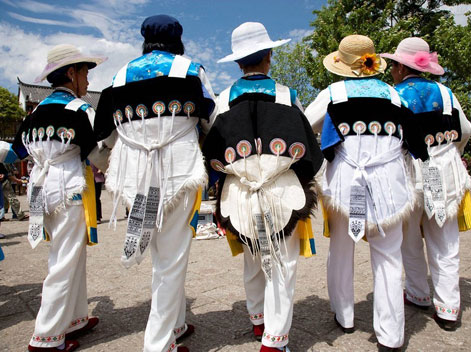
Baishaxiyue is called "Baishixili" or Bieshixieli in Naxi language. According to legend, it is from the music pieces of the Yuan Dynasty. It is said that when Kublai Khan, the first emperor of the Yuan Dynasty, led his south expeditionary armies to conquer Dali, the troops stayed on their way in Lijiang for a while. The Emperor and his troops were welcomed and well received by Aliang, the then leader of the Naxi people. As they departed Lining, the emperor gave Aliang some band men and left behind some music books as gift. That is why the music is called "Bieshixieli" meaning "farewell gift". But some say that it is a folk music invented by Naxi people in the inception years of the Yuan Dynasty used as a requiem for the fighters died in the war. The record says, "when Mu's family was in its heyday, intruders from Yongning County molested Lijiang. Mu and troops ambushed the intruders at Basha and wiped them out. People there invented the music to express condolence on their death". That is why it is called "Baishixili". Although there are different explanations to the origin of the music, all agree that it is a music expressing feelings of life and death, nostalgia, sadness and being gut-wrenching.
Baisha is an ancient and scenic village at the foot of Yulong Mountains, used to be a center of politics, economy and culture for the Naxi. "xiyue" is contrary to "chuyue". The tone produced by Suona, a mouth instrument, is called "chuyue" or "xiyue", otherwise, it is called "xiyue".
In history, Baishaxiyue includes chapters of Prelude, A Letter, Three Thoughts, Beautiful Clouds, Crying of Princess, Lark Dance, Barefooted Dance, Arrow Dance, South Music, North Music Lichee Flower and Crying of Sky. It is an orchestrated music with the number of music players being flexible. When it is played, it is accompanied by songs and dances. The music is tinged with local features. It reflects high mountains, flowing waters, clouds or Naxi people's life at the foot of Yulong Mountains when they build water conservancy facilities, field irrigation and agricultural harvest. It bears profound meanings with simple and true tones, demonstrating Naxi people's artistic thinking and creativity.
Baisha is an ancient and scenic village at the foot of Yulong Mountains, used to be a center of politics, economy and culture for the Naxi. "xiyue" is contrary to "chuyue". The tone produced by Suona, a mouth instrument, is called "chuyue" or "xiyue", otherwise, it is called "xiyue".
In history, Baishaxiyue includes chapters of Prelude, A Letter, Three Thoughts, Beautiful Clouds, Crying of Princess, Lark Dance, Barefooted Dance, Arrow Dance, South Music, North Music Lichee Flower and Crying of Sky. It is an orchestrated music with the number of music players being flexible. When it is played, it is accompanied by songs and dances. The music is tinged with local features. It reflects high mountains, flowing waters, clouds or Naxi people's life at the foot of Yulong Mountains when they build water conservancy facilities, field irrigation and agricultural harvest. It bears profound meanings with simple and true tones, demonstrating Naxi people's artistic thinking and creativity.
Source:
http://traditions.cultural-china.com/en/17Traditions10151.html





